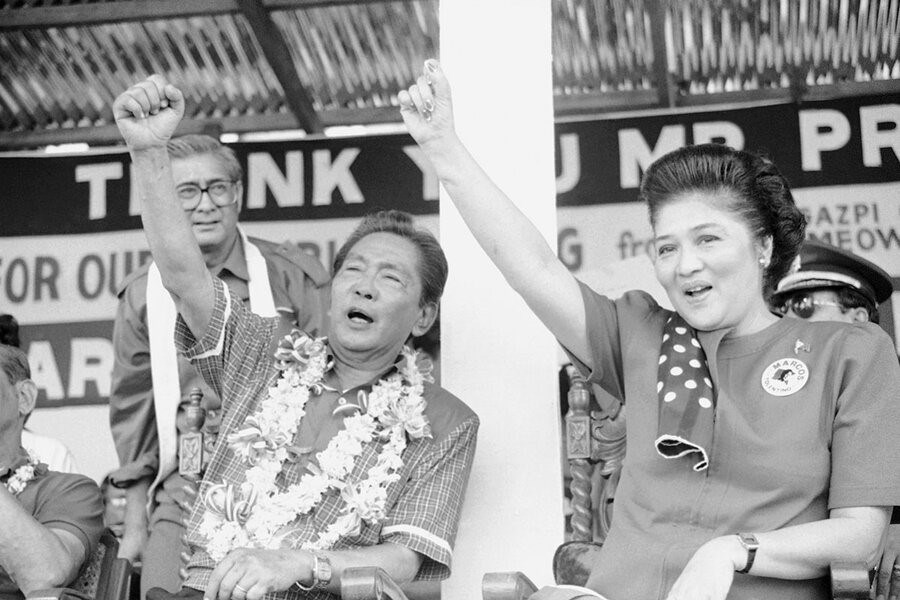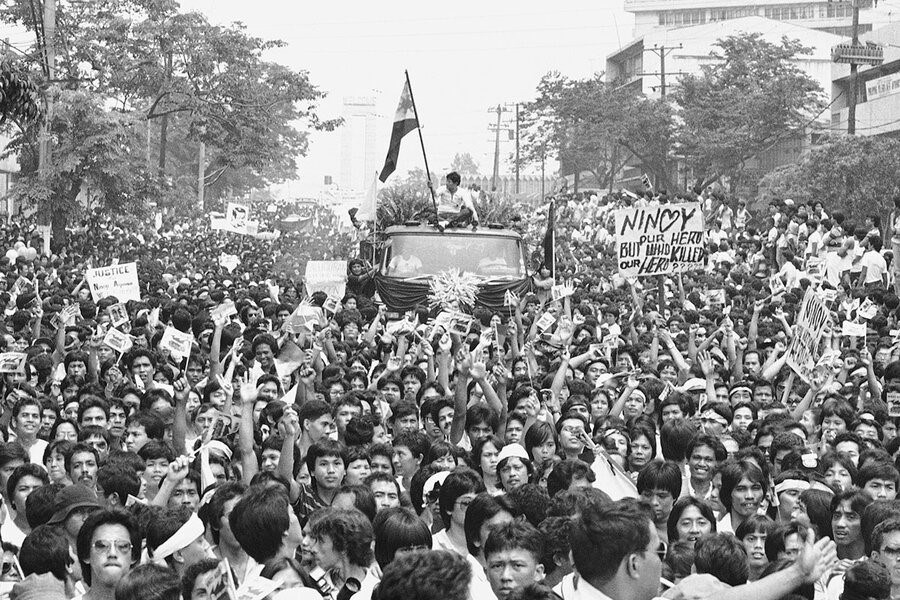REPRINTED WITH PERMISSION FROM THE CHRISTIAN SCIENCE MONITOR
 President Ferdinand E. Marcos and his wife, Imelda, raise clenched fists in response to cheers from supporters on Jan. 14, 1986 in Legazpi, Philippines. Val Rodriguez/AP/File
President Ferdinand E. Marcos and his wife, Imelda, raise clenched fists in response to cheers from supporters on Jan. 14, 1986 in Legazpi, Philippines. Val Rodriguez/AP/File
March 17, 2023
Two new films are going head to head in theaters across the Philippines this month, both claiming to be based on verifiable and documented evidence but offering dramatically different versions of the country’s dark period of martial law.
“Oras de Peligro” (Time of Danger) combines archival footage with dramatization to depict the final days of the 1986 People Power Revolution, focusing on the perspective of a regular, working-class family who suffered under the regime of former President Ferdinand Marcos.
“Martyr or Murderer” delves into the experiences of his daughter, Sen. Maria Imelda Josefa “Imee” Marcos, who is also the film’s creative producer. It spans from her father’s days as a young politician through the family’s life post-ouster, and paints an unflattering picture of former Sen. Benigno “Ninoy” Aquino, whose 1983 assassination helped spur the uprising.
“Oras de Peligro” and “Martyr or Murderer” have each been criticized for distorting the truth, reflecting a deep schism in Filipinos’ understanding of how the martial law period actually unfolded and the people at its center. It’s a divide highlighted by the rise of President Ferdinand “Bongbong” Marcos Jr., whose 2022 election victory was seen by many as the culmination of a decadeslong rehabilitation campaign by the Marcos family, which sought to downplay the atrocities committed under their patriarch.
Francisco Jayme Guiang from the University of the Philippines’ history department, says the films “offer two different things – the perspective of the big names in Philippine history, and the perspective of ordinary Filipinos.”
“But the question is, are these perspectives honest, right, and factual?” he says. “One thing that is good with these kinds of movies getting in cinemas, is that this period of history is being talked about. We can see the discourse. Our interpretation of the past is being contested, particularly during the period of the military rule of Marcos Sr.”
 Aaron Favila/AP/FileShortly after President Ferdinand Marcos Jr. took office, Joel Lamangan (second from left) and other activists demonstrated in Quezon city, Philippines, July 21, 2022, to prevent a repeat of the abuses committed under Mr. Marcos Jr.'s father. Mr. Lamangan's new film, “Oras de Peligro” (Time of Danger), combines archival footage with dramatization to depict life during the senior Mr. Marcos' rule.
Aaron Favila/AP/FileShortly after President Ferdinand Marcos Jr. took office, Joel Lamangan (second from left) and other activists demonstrated in Quezon city, Philippines, July 21, 2022, to prevent a repeat of the abuses committed under Mr. Marcos Jr.'s father. Mr. Lamangan's new film, “Oras de Peligro” (Time of Danger), combines archival footage with dramatization to depict life during the senior Mr. Marcos' rule.
Battle of narratives
While “Oras de Peligro” director Joel Lamangan has said his film has “no intention to criticize or favor” any political figure, observers consider it a clear rebuttal to “Martyr or Murderer,” which is the second installment in a trilogy of pro-Marcos films directed by Darryl Yap, the first being “Maid in Malacañang” (2022).
The country is witnessing “a battle of narratives,” says Karl Patrick Suyat, head of Project Gunita, a digital repository of books, magazines, and newspaper clippings that shine a light on martial law injustices.
“It is not really a battle of facts,” says the archivist, who has seen both movies. “It is how filmmakers package these facts in the form of propaganda.”
Historians have long sounded alarms over the Marcos family’s aggressive use of any platform, from social media to TV interviews, to promote their own version of history. But political scientist Antonio Contreras argues in his Manila Times column that “Oras de Peligro” also fits the propaganda bill. What “heightens the element of propaganda” in that film, he explains, “is the suggestion that the suffering of the family was unique to the period as if it was only martial law and Marcos that can inflict such injustice.”
And at least in the box office, the pro-Marcos narrative is winning. “Martyr or Murderer” reportedly earned between $145,000 to $271,000 U.S. dollars on its first showing day, compared to around $9,000 in ticket sales of its rival, which also opened on March 1. Its success is at least partly due to the fact that “Martyr or Murderer” is playing in more than 250 cinemas compared to the 108 of the anti-dictatorship film. “Martyr or Murderer” has also debuted in several foreign countries.
Alvi Siongco, one of the “Oras de Peligro” producers, says his team is planning to release the film internationally, but promoting it in the Philippines is their priority.
“This film is about the truth and truth is our weapon. People must use this weapon against any attempt to distort history, especially now that there are people who are using art or films to spread disinformation. And we cannot allow that to flourish,” he says.
 Andy Hernandez/AP/FileThrongs of people walk with the coffin of the late Benigno "Ninoy" Aquino through the streets of downtown Manila, Aug. 31, 1983. The former senator's assassination helped spark the People Power Revolution which ultimately ousted President Ferdinand Marcos in 1986.
Andy Hernandez/AP/FileThrongs of people walk with the coffin of the late Benigno "Ninoy" Aquino through the streets of downtown Manila, Aug. 31, 1983. The former senator's assassination helped spark the People Power Revolution which ultimately ousted President Ferdinand Marcos in 1986.
Facts versus fiction
On a recent Sunday afternoon, a lighthearted family outing to see “Martyr or Murderer” ended in a heated argument at a Manila mall, with Jasper Calderon insisting to his father that there was “no evidence” linking Mr. Aquino to the country’s communist rebels, an unfounded claim repeated by Marcos allies and aimed at tarnishing Mr. Aquino’s legacy.
“The movie has shown the proof,” his father bellowed, throwing out his hands for emphasis.
Neither Jasper nor his father are staunch supporters of any political family, but they have two colliding interpretations of the film. The elder Mr. Calderon was convinced that “Martyr or Murderer” was an honest portrayal of the period, whereas his son, a marketing executive in Quezon City, took issue with how it presented “new claims without providing enough context.”
“I watched the film because I really wanted to hear the Marcos family’s side of the story,” he says, “but there are claims shown in the movie that needed context and hard proof, especially claims against Ninoy,” or Mr. Aquino.
In the film, Mr. Aquino is presented as self-absorbed and sexist. The filmmakers also used Mr. Aquino’s wife and former President Corazon “Cory” Aquino’s own words during her interview with Vanity Fair in 1988. “My husband, well, he was a male chauvinist,” she told the magazine.
As much as these films may spark interest in Philippine history, experts worry about viewers taking them at face value.
“People have a tendency to believe whatever is presented in a film that claims to be … about history,” says Professor Guiang, from the University of the Philippines.
Ultimately these movies are “creative works,” says Francis Gealogo, a historian from Ateneo de Manila University and a former commissioner of the National Historical Commission of the Philippines. “There is a difference between a historical film and a period film.”
For his part, Jasper Calderon welcomes films like “Martyr or Murderer” and “Oras de Peligro,” warts and all. He thinks they ought to be shown to a wider audience for free.
“Let them spark debate and discord,” he says. “It is only through a conflict of perspectives and narratives, even with our own family or community, that truth reveals itself.”
Related stories
Page created on 3/21/2023 7:11:17 PM
Last edited 3/21/2023 7:31:17 PM
